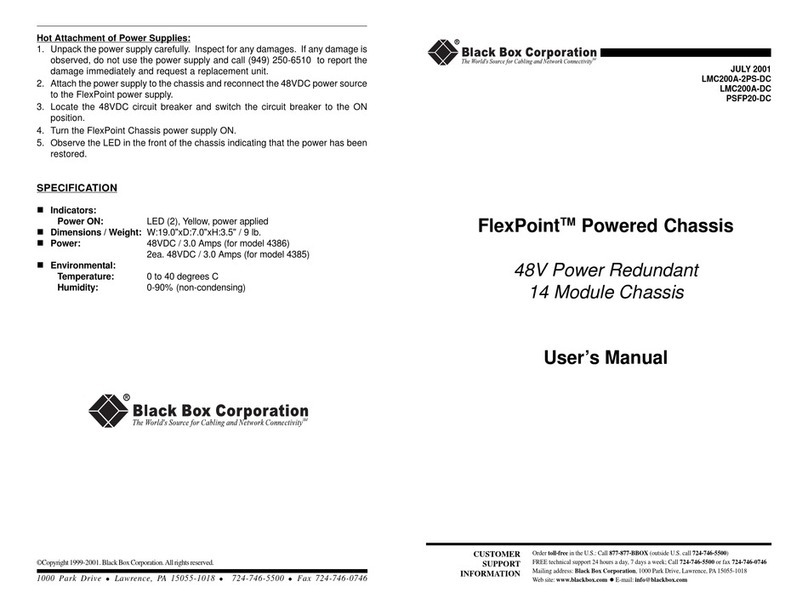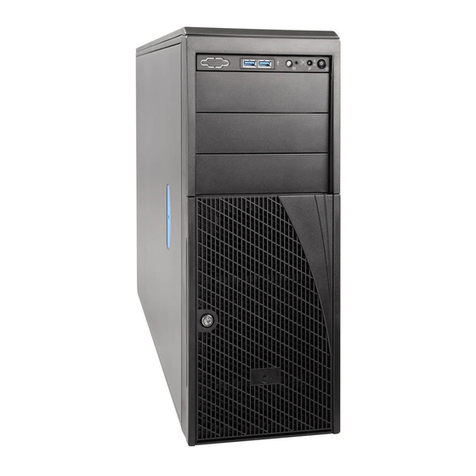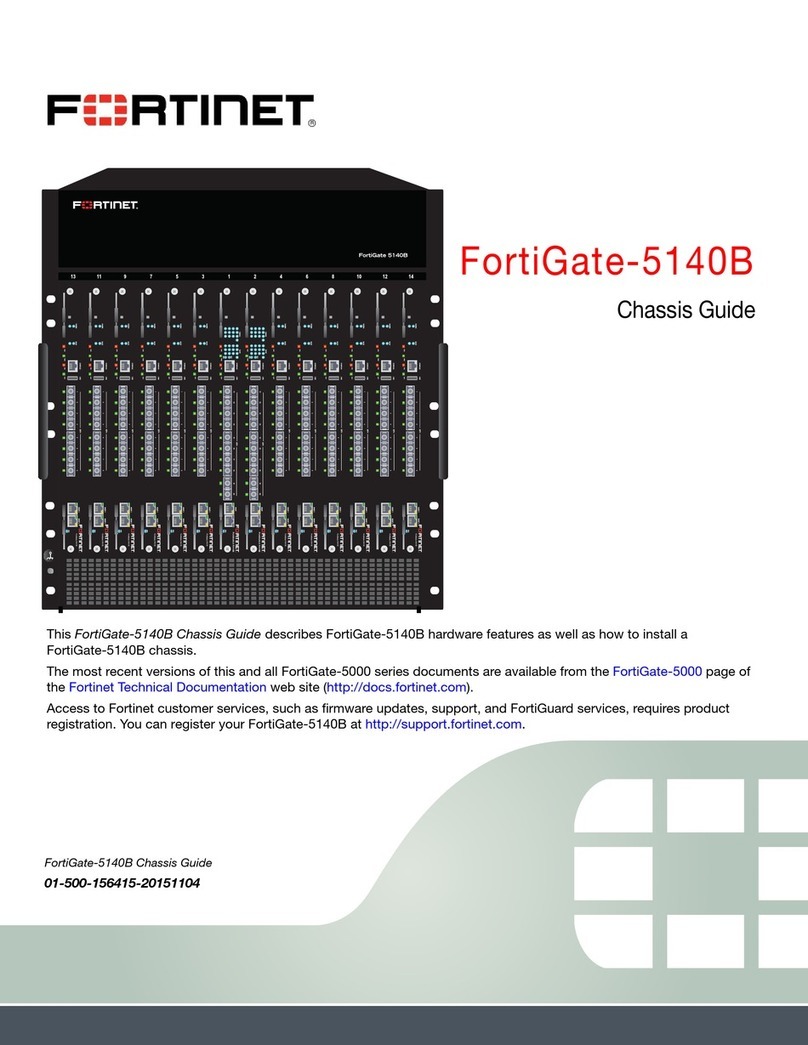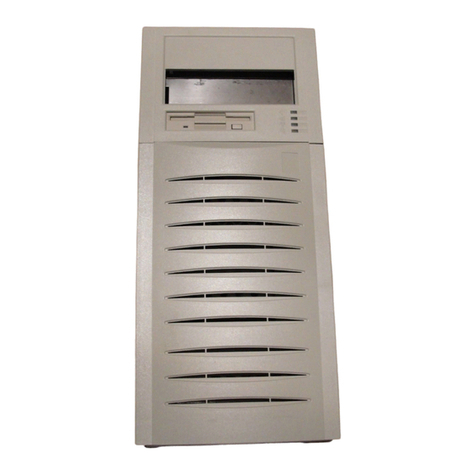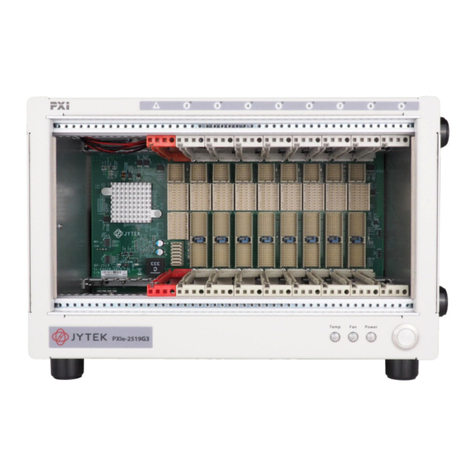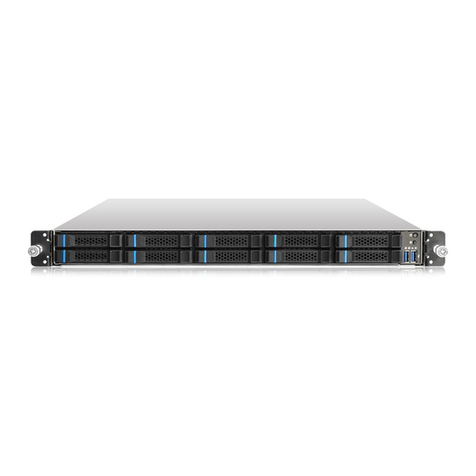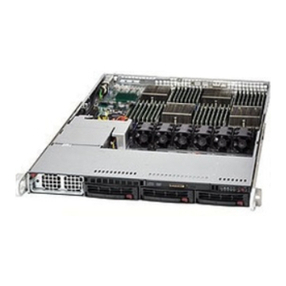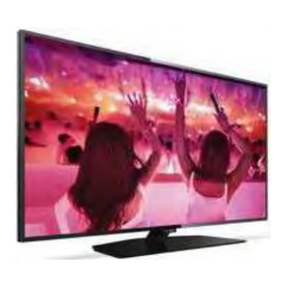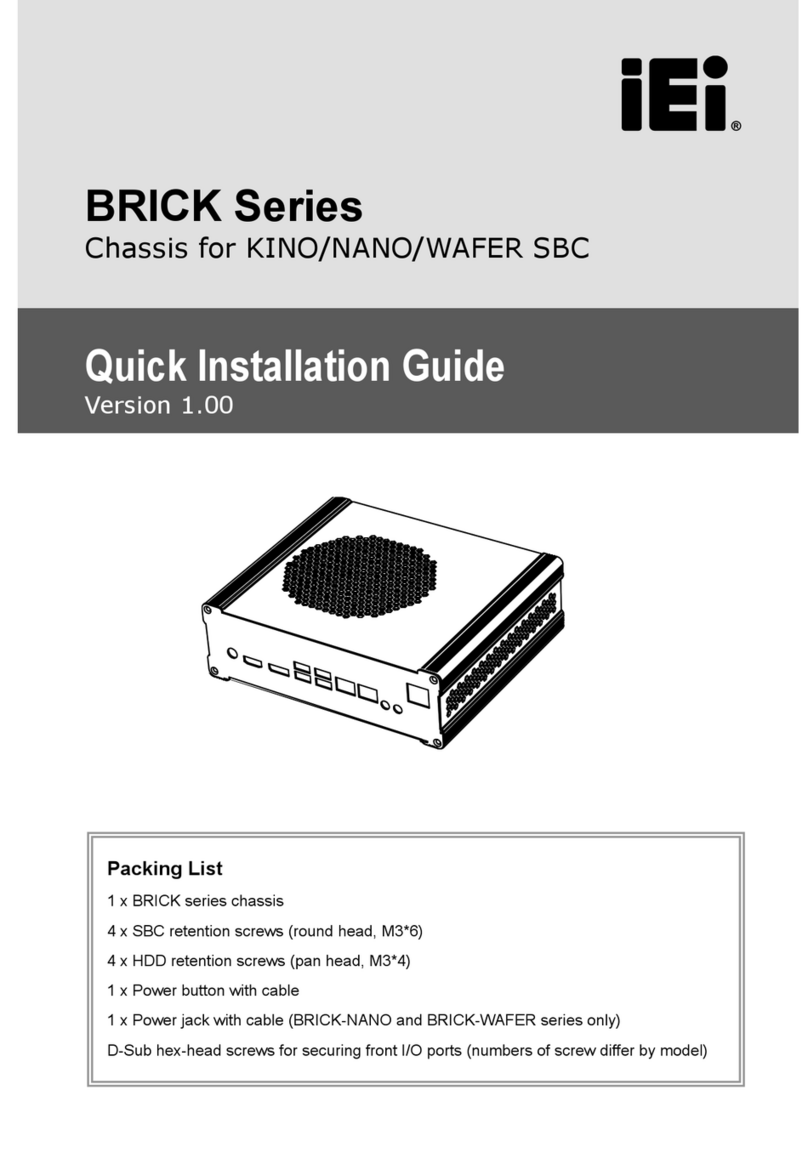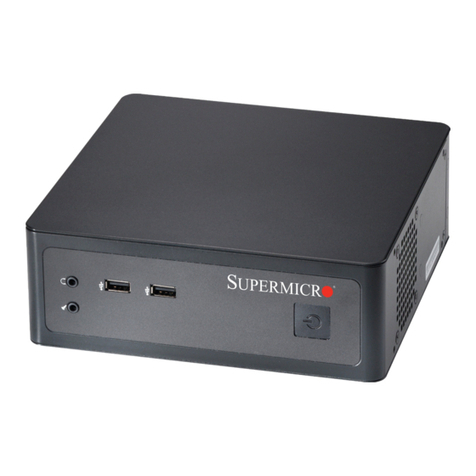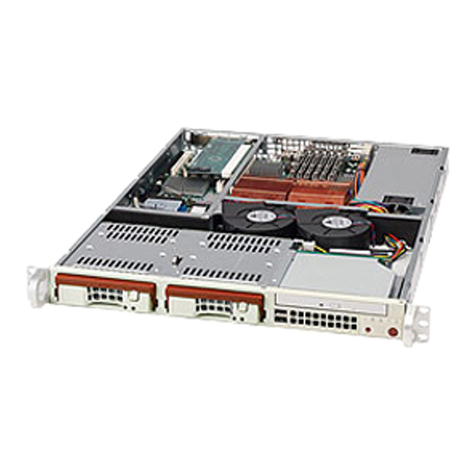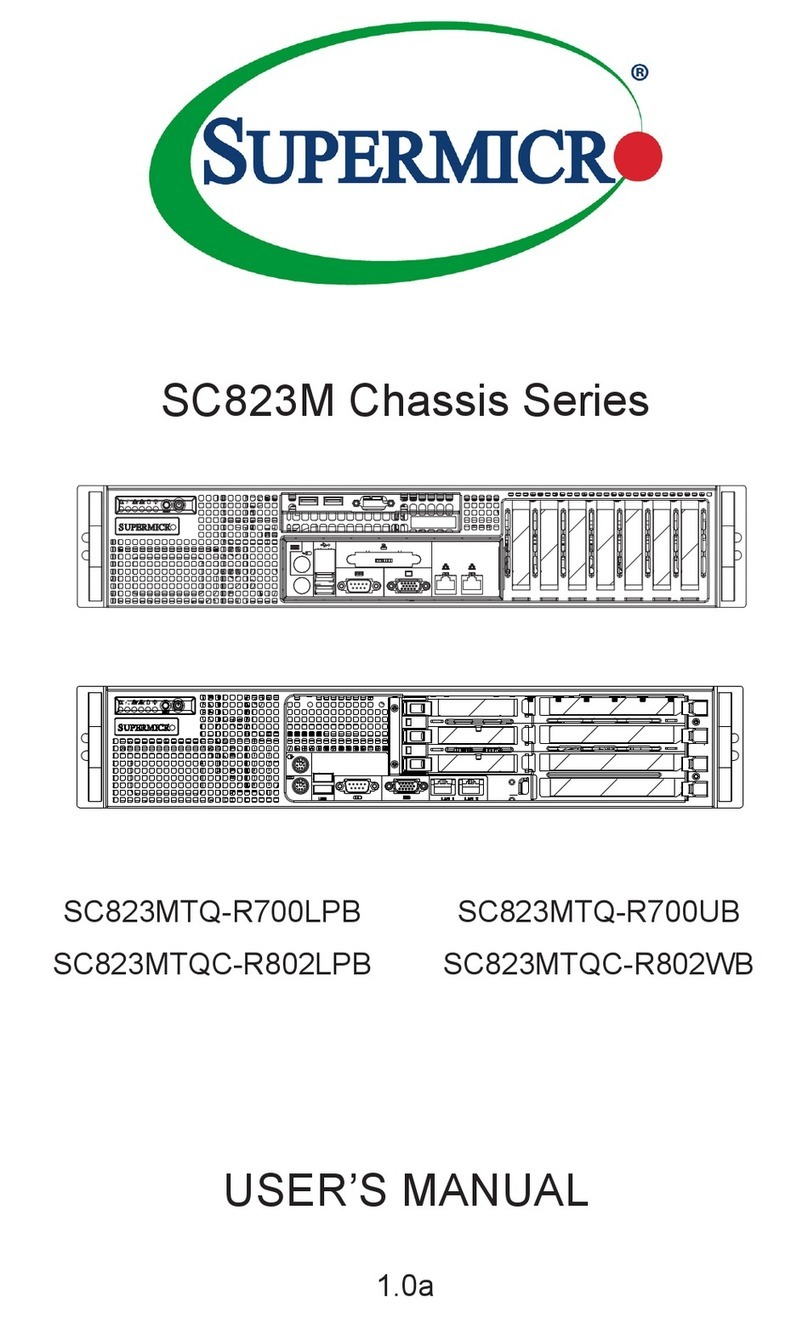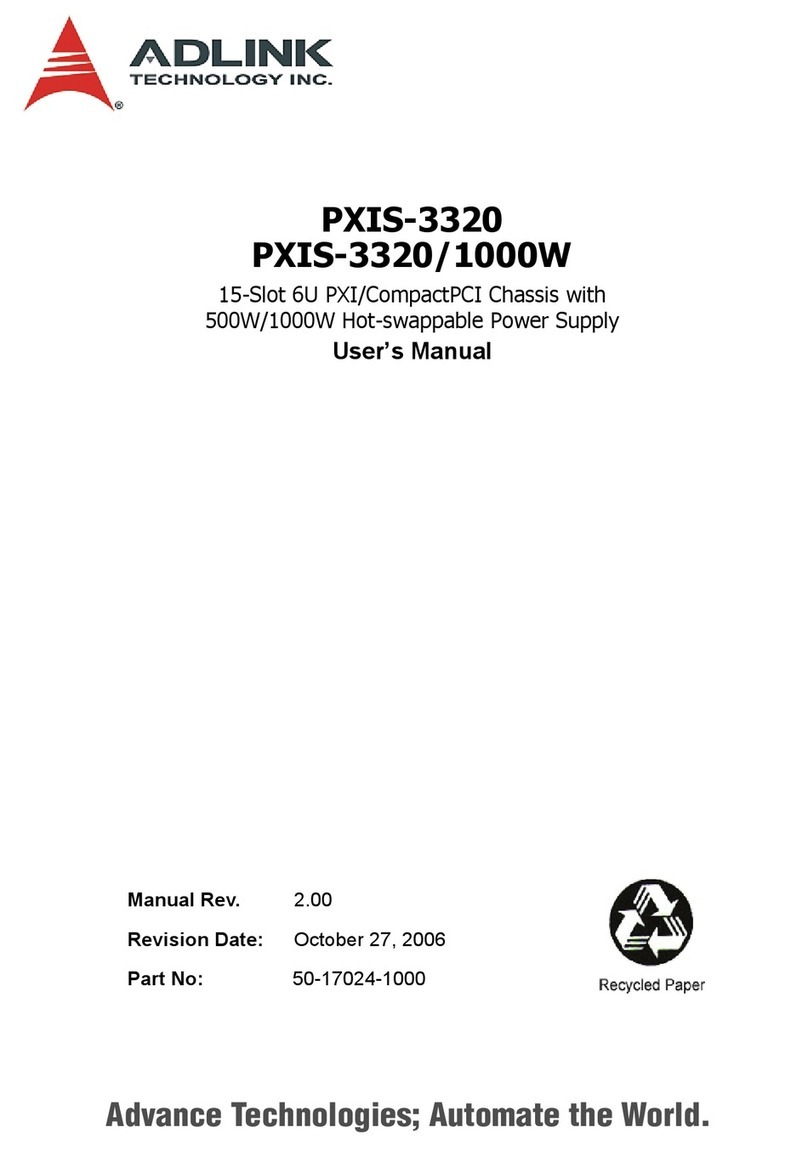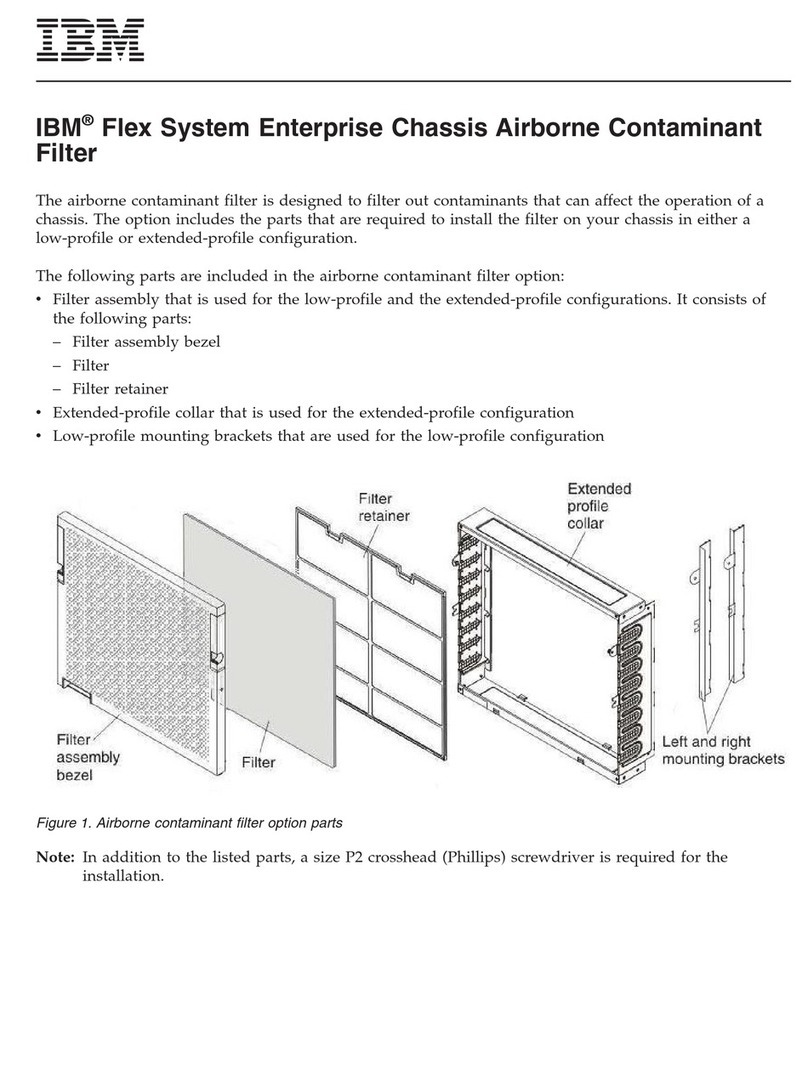Black Box MT850A User manual

1
Includes controller
card with dual T1
interfaces.
To add new services,
just slide in hot-
swappable cards.
Deploy any service
connection or network
access line in any of
its six slots.
VoI card available for
sending voice and
data over TC /I .
Manage in-band or
out-of-band via the
Internet.
AC and DC power
sources.
Integrated CSU/DSU
for T1 lines.
Rackmount with
optional kit.
F
or multiservice providers,
i
nstalling and maintaining
separate data and voice services
can be an expensive endeavor.
And as end users continue to
demand newer services, the task
isn’t going to get any easier without
a flexible, bandwidth-efficient
solution in place.
The LACK OX
®
Compact
T1 Channel ank is that solution.
Modular in design, the channel
bank is a 2U-high rackmountable
chassis that enables you to
optimize and add services to
users and reduce your hardware,
deployment, and maintenance
costs. With it, you can provide
carrier-quality broadband data
and voice in a wide range of
applications—whether it‘s a wired,
wireless, or IP network one—
and not clutter your wiring closet,
central office, or wireless radio site
with numerous standalone boxes.
The channel bank is ideal for
ISPs, ILECs, MSOs, IXCs, CLECs,
and wireless mobility carriers who
want to economically give their
customers a number of voice and
high-speed data services.
Combine T1 digital cross-connects
with voice, data, and Internet access
in one scalable platform!
KeyFeatures
COMPACTT1CHANNELBANK
Out of the box, the Compact
T1 Channel ank comes with a
preinstalled T1 Controller Card that
has dual RJ-48C interfaces, so it’s
ready-made for connecting to
one or two T1 lines. oth ports
support speeds of 1.544 Mbps
(±50 bps).
ecause the channel bank
features a built-in digital cross-
connect that communicates at the
DS0 level, you can deliver voice
and data services over one or more
T1s or the Ethernet WAN to make
the most of available bandwidth
in a compact platform.
To configure the chassis, you
have a number of access options.
One way is to use a Telnet
connection through its rear
10-Mbps RJ-45 Ethernet interface.
Or configure it through a console
by linking to it through the rear
RS-232 port.
The chassis’ rear panel also
has two 25-pair telco connectors
for attaching telephony devices.
These tip and ring analog
interfaces have standard 25-pair
telco connectors for connecting
key systems, fax machines,
modems, P Xs, or similar
equipment to the Compact T1
Channel ank. The interfaces can
also be used as ISDN RI ports.
The rear panel also has an
external 6-screw terminal block for
inputting and outputting major and
minor alarms.
On the card side, the Compact
T1 Channel ank features six
available service slots, which
enable you to connect to a variety
of voice and data services, mixing
and matching the connection types
by simply installing the cards you
need. Within this expandable
platform, the cards provide the
physical, electrical, and logical
connections for terminating analog
lines, P X interfaces, LAN-to-WAN
connectivity, network access, and
more.
This modularity makes the
channel bank an ideal alternative
to using bulky standalone boxes.
You get maximum service within
a smaller footprint!
For chassis power, the unit has
both 115 VAC and -48 VDC sources.
You can use the -48 VDC input
connector for either direct DC
Black Box Corporation • 1000 Park Drive • Lawrence, PA 15055-1018 • Tech Support: 724-746-5500 • www.blackbox.com • e-mail: [email protected]
© 2003. All rights reserved.
lack ox Corporation.
08/6/2003 #10652

2
RearPanelof
theCompactT1
ChannelBank
power or for a battery backup
connection when using the AC
power source. For added
protection, the chassis features
a resettable circuit breaker. If
there‘s a short or power surge
on the incoming AC/DC line, the
breaker will trip to protect the
supply from damage.
The Compact T1 Channel ank
offers several local and remote
management options. Cards can
be configured and managed locally
through either the RS-232 interface
(by using a VT100™ terminal, PC, or
modem) or via the Ethernet port to
the chassis’ T1 Controller Card.
RS-232 Management Port
DC Power Input
10 ASE-T
Management Port
(2) T1
Interfaces on
Rear of
Installed T1
Controller Card
(Included)
Alarm Management Port
Tip and Ring Telco
Connector (Lines 25–48) Tip and Ring Telco
Connector (Lines 1–24)
AC Power Input
For troubleshooting the channel
bank off-site, the chassis features
a dedicated, in-band DS0
management channel that provides
64-kbps remote access to the unit.
You can also use the 10 ASE-T
Ethernet connection for out-of-
band SNMP network management
of TCP/IP networks. Daisychain
several channel banks and use
SNMP at a central network
management station to manage
both local and remote units.
For quick and easy
wallmounting, the Compact T1
Channel ank comes with a
mounting bracket attached. We
also offer a rackmount kit for
mounting in a 19" rack or cabinet.
T1 Controller Card (Included)
The controller card that comes
with the chassis includes two T1
ports with integrated CSUs as well
as a built-in 1/0 cross-connect
matrix that provides full, non-
blocking connectivity between
the card and any of the cards in
the slots. To increase the total
T1 capacity of the Compact T1
Channel ank to 18 network
access trunks or drop-and-insert
user connections, you would simply
add a full complement of 4-Port T1
Cards (MT854C) to the slots (for
more on the MT854C, see page ).
Manage the T1 Controller Card
locally using its front-panel DIP
switches or through the Command
Line Interface (CLI) using an ASCII
terminal or PC with terminal
emulation software, or a modem
that uses XMODEM or PPP
sessions.
Six front-panel LEDs quickly
communicate alarm and T1 line
status, as well as mode of
operation. To manage the card
remotely, use either an in-band DS0
management channel or a separate
SNMP Ethernet connection.
DS0ManagementwiththeCompactT1ChannelBank
Compact T1 Channel anks (MT850A)
Populated with Various Cards, with
Front-Panel T1 Connections Terminated
at 4-Port T1 Cards (MT854C)
Compact T1 Channel anks (MT850A)
Populated with Various Cards, with
SNMP Workstation Connection
Terminated at IP Router Card (MT857C)
T1 Line
T1 Line
T1 Line
T1 Line
T1 Line T1 Line
Digital Cross-Connect
PSTN
(24) DS0
(Only 1 DS0
Shown)
T1 Line
T1 Line
Cell Tower
Cell Tower
Cell Tower
Cell Tower
Cell Tower
SNMP Workstation
The Compact T1 Channel Bank features a DS0 management channel , which you can use for SNM management and remote access. This channel,
which enables full TC /I connectivity to a remote Compact T1 Channel Bank, can also be used for Trivial File Transfer rotocol (TFT ) upgrades of
the T1 Controller Card and service cards as well as remote Telnet access.

3
Service card options:
As with the Compact T1 Channel ank’s included T1 Controller Card,
the optional cards can be locally configured using the front-panel DIP
switches or the Command Line Interface (CLI). Manage them locally or
remotely by using the interfaces built into the Compact T1 Channel ank
platform.
Front-panel LEDs on all service cards quickly inform of their status
and vary depending on the card you order.
Hot-swappable, the cards can be added or removed without powering
down the chassis.
8-Port FXS Card
This analog voice card enables up to eight direct phone connections
through the Compact T1 Channel ank, delivering either outside phone
lines or on-premise customer business line services from T1 access
circuits. Up to 6 of these cards can be added to the channel bank for
48 Foreign Exchange Station (FXS) connections.
Automatic impedance balancing provides echo-free service
connections for a wide range of customer equipment and line conditions.
V.90 transmission ensures optimal dial-up modern performance.
The 8-Port FXS Card supports Caller ID, three-way calling ID,
distinctive ringing, and E&M signaling conversion.
8-Port FXO Card
The FXO Card provides high-density provisioning of reliable Foreign
Exchange Office (FXO) or Direct Inward Dialing (DID) telephone services
for T1 access circuits. You can add up to 6 of these cards to the chassis
for 48 connections.
The FXO function sinks battery current and detects ringing voltage
originating from a central office or P X line, so you can extend dial tone
and calling features to remote locations. When configured as a DPT
interface, the channels sink and detect forward and reverse line current,
emulating the functions of a central office DID line.
The 8-Port FXO Card supports Caller ID, calling party disconnect,
distinctive ringing, ground start, and E&M signaling conversion.
As with the FXS Card, the FXO Card’s automatic impedance balancing
provides echo-free service connections for a wide array of customer
equipment and line conditions. V.90 transmission ensures optimal dial-up
modem performance.
4-Port OCU-DP Card
The Office Channel Unit Data Port (OCU-DP) Card essentially provides
the electrical and physical termination of a 4-wire Digital Data Service
(DDS) baseband connection that interfaces with a remote CSU/DSU. Up
to 6 of these cards can be inserted into the channel bank chassis for up
to 24 connections.
Use the card to link up to four CSU/DSUs that are connected to remote
bridges, routers, and other network devices and provide standards-based
DDS access for service subscribers or users at their data terminals. The
4-Port OCU-DP Card features scalable, independently configurable,
synchronous data service rates from 2.4 to 64 kbps.
In addition to interconnecting lower-speed serial synchronous DTEs
and terminating DDS circuits, you can use the OCU-DP Card alongside
DS0 voice, fractional T1 data, or other cards in the Compact T1 Channel
ank for a truly integrated solution.
8-Port ISDN Card
This card enables you to deliver high-density, standards-based ISDN
asic Rate Interface ( RI services over one or more T1 or DSL access
lines using TDM or ATM transport. This means you can deploy ISDN
voice, data, and real-time video applications as part of any integrated
broadband service. For instance, you can economically bundle ISDN
with all other services at 64 kbps or 128 kbps over T1 access lines.
Up to 5 of the cards can be used in the chassis for a maximum of
40 ISDN RI circuits.
Configure the card as either a line unit line terminal (LULT) for making
connections to ISDN switch interfaces at the central office, or as a line
unit network terminal (LUNT) for the customer premises. The 8-Port
ISDN Card provides direct NTU service demarcation for ISDN video
conferencing, 128-kbps dial-up Internet, point-of-sale terminals, and
ISDN Centrex or telephone applications.
4-Port T1 Card
Add ports for up to four T1 lines with this card—whether you need
to backup existing T1 line connections or add connect additional DS0
channels. This way, you can economically provide and expand your T1
bandwidth with full non-blocking digital cross-connection of all timeslots
to any Compact T1 Channel ank service card.
Service providers or enterprise network managers, for instance, can
use the card to cost-effectively add and expand network or drop-side T1
bandwidth. The card supports a number of network access technologies,
including fractional and full T1 data and voice trunking.
Combine the 4-Port T1 Card with the Compact T1 Channel ank’s
already-installed T1 Controller Card to support up to 18 T1 access lines—
which is enough for most small- to medium-sized businesses, multi-tenant
units, fixed or mobile wireless backhaul applications, and end-office uses.
Working with the T1 Controller Card, the 4-Port T1 Card provides local and
remote management functions.
Up to 4 of these cards can be added to the chassis for a total of 18 T1
connections (taking into account the two connections provided by the T1
Controller Card).
2-Port V. 5 Card
This service card enables you to set up connections to high-speed
serial synchronous data terminal equipment (DTE) devices, such as
routers, Frame Relay access devices (FRADs), and videoconferencing
equipment. Use it, for instance, to integrate Frame Relay or private V.35
services with voice and Internet access over T1 lines. The card features
integrated T1 CSU/DSU functionality.
The 2-Port V.35 Card provides scalable high-speed data service
capacity to meet growing needs of users. Each of the card’s V.35 ports
supports any n x 56-/64-kbps rate up to 1.536 Mbps, and both ports can
operate simultaneously at any supported speed.
Flexible clocking enables loop timing from any T1 line and provides
system clocking to the connected DTE. It also supports adaptation and
transport over TDM facilities.
Add a maximum of 6 cards to the Compact T1 Channel ank chassis
for connections to 12 fractional T1 V.35 connections from two T1 network
connections. Depending on your application, you’ll need to order one or
more V.35 data cables.
IP Router Card
With its own dedicated processor, this card offers the performance
and expandability of a dedicated router in a modular format. It’s ideal for
providing high-speed Internet and Intranet connectivity to small and
medium-sized businesses, as well as remote- and branch-office users.
The IP Router Card offers powerful IP and IPX routing, 3,000-packets-
per-second throughput, and Layer 2 bridging plus networking security
and management capabilities. All it takes is a single unique IP address
to configure and manage a number of IP Router Cards installed in the
Compact T1 Channel ank chassis. You can add a maximum of six cards
to the chassis, and each card acts as a single 10-/100-Mbps Ethernet
router with autosensing abilities.
ecause the IP Router Card uses Multi-Link Point-to-Point Protocol
(ML-PPP) for bandwidth scalability, you can support the growing needs
of your customers by offering more than just one or two T1s—multiple
T1 facilities can function as a single IP WAN interface, providing up to 60
DS0s of bandwidth or up to 24 WAN connections per a card for multipoint
networking. This flexibility enables service providers to target multitenant

4
units with a single device that supports business-class voice, Internet-
access, and data services.
The IP Router Card also supports Point-to-Point Protocol (PPP), Frame
Relay, PPP in Frame Relay, and GRE tunneling, as well as packet filtering,
Spanning Tree Protocol (STP), and Dynamic Host Configuration Protocol
(DHCP).
With three levels of security, the IP Router Card keeps
communications safe. It supports PAP and CHAP, Network Address
Translation (NAT), NAT ypass, Port Address Translation (PAT), and
RADIUS login authentication.
Media Gateway VoIP Router Card
This card combines IP router functionality with the ability to translate
circuit-based voice services into packet-based Voice over IP (VoIP).
Installed in the Compact T1 Channel ank, the Media Gateway VoIP
Router Card enables you to packetize voice services using the Media
Gateway Control Protocol (MGCP). This way, you can establish a
standards-based voice processing, call control, and signaling
communications. As a service provider, for instance, you can offer
CLASS (Custom Local Area Signaling Services) and IP Centrex services
in which customers can share data and voice via the same line.
The card also provides IP routing and bridging between LAN and
WAN connections for VoIP and data traffic, plus IP QoS (Quality of
Service)/policy management features. A built-in 10 ASE-T/100 ASE-TX
Ethernet port enables you to connect to voice or local LAN traffic.
Integrated routing protocols ease the job of deploying the card in a
network. The card also supports multiple types of softswitches, so
connecting telephony services through the media gateway to VoIP
services isn‘t a problem either.
What’s more, the Media Gateway VoIP Router Card features voice
compression, silence suppression, comfort noise generation, and echo
cancellation. Distinctive ringing, Call Waiting, DTMF tone detection, call
progress tone generation, and Caller ID are just a few of the many
signaling and service solutions are also supported by the card. You can
even tailor tone databases to support call-progress tones and cadences
for a specific country. Selectable FXS impedances provide worldwide
coverage of line impedance variations.
A maximum of six Media Gateway VoIP Router Cards can be installed
in the Compact T1 Channel ank.
SpecificationsforCompactT1ChannelBandandT1ControllerCard
Compact T1 Channel Bank:
Approvals: UL
®
60950; FCC Part 15,
Class A and Part 68; NE S Level 3
certified for Type 2 and 4
equipment; CSA C22.2 No. 60950-
00; ICES-003, Class A; CS-03; NOM
19 and 152
Alarms: External 6-screw terminal
block; (1) input/(2) outputs for
major/minor alarms; T1: LOS, PV,
Yellow, LOF/AIS
Clocking: T1 reference timing with
holdover, internal clock with
holdover
Cooling Method: Free air convection
(requires long axis of unit to be
mounted horizontally)
Diagnostics: T1 loop code;
V.54 loop codes; QRSS, 2047, 2E20-
1, 2E15-1 test patterns
Framing: SF (D4) or ESF
Management: SNMP over 10 ASE-T
or dedicated DS0; remote
management over T1 ESF facility
data link or dedicated DS0
Network Standards: ANSI/TIA T1.403
ESF FDL; T1.403-1995
Interface: T1 (1.544 Mbps ± 50 bps)
Connectors: T1: (2) RJ-48C;
Ethernet: (1) RJ-45;
RS-232: (1) D 9 F (console port);
Telco: (2) 25-pair connectors;
Alarms: (1) 6-screw terminal
block
Humidit Tolerance:
Up to 95% noncondensing
Temperature Tolerance:
Operating: 32 to 104ºF
(0 to 40ºC);
Storage: -40 to +158ºF
(-40 to +70ºC)
Power: AC (90–135 VAC, 60 Hz) or DC
(-42 to -60 VDC @ 3.5 A maximum)
Size: 3.5"H (2U) x 8.5"W x 12"D
(8.9 x 21.6 x 30.5 cm)
Weight: 11.8 lb. (5.4 kg) fully loaded
T1 Controller Card (Included):
Approvals: UL
®
60950; FCC Part 15,
Class A; FCC Part 68; NE S Level 3
certified; GR-63-CORE, GR-1089-
CORE; CSA C22.2 No. 60950-00;
ICES-003, Class A; CS-03
Advanced Capabilities: RADIUS
login authentication; syslog; NTP
Alarms: (1) major and (1) minor alarm
output; (1) one alarm input; alarm
contacts accessible from external
alarm connector; all alarms are
logged in an event log; loss of AC
power triggers minor alarm;
generates SNMP traps for
alarming (MI objects)
Clocking: Loop-timed from any T1;
revertive clock switching provides
automatic backup to secondary
T1 should the primary T1 fail;
operates as a 4E Stratum clock
with hold over
Diagnostics: Standard T1 line and
payload loopbacks; T1.231
performance history
Network Standards: AT&T
®
Pub
54016, TR 62411; ANSI T1-403,
T1.102, T1.231
T1 Interface: Selectable single or
dual T1 ports
T1 Framing: SF (D4) or ESF
T1 Encoding: 8ZS or AMI
T1 Line Build Out (DSX-1):
655 ft. (200 m)
T1 Receive Sensitive (DS1):
0 to -22.5 d
T1 Protection: Solid-state (fuseless)
overvoltage and overcurrent
protection; Telcordia GR-1089-
CORE intra-building
lightning/power cross limits
T1 Speed: 1.544 Mbps ± 50 bps
Connectors: (2) RJ-48C (on rear of
Compact T1 Channel ank)
Size: 3.5"H x 0.75"W x 11.25"D
(8.9 x 1.9 x 28.6 cm)
Weight: 0.4 lb. (0.2 kg)

5
8- ort FXS Card:
Approvals: UL
®
60950; FCC Part 15,
Class A; NE S Level 3 certified for
Type 2 and 4 equipment; GR-63-
CORE, GR-1089-CORE; CSA C22.2
No. 60950-00; ICES-003, Class A
Connectors: RJ-21X (rear panel)
Size: 3.5"H x 0.75"W x 11.25"D
(8.9 x 1.9 x 28.6 cm)
Weight: 0.4 lb. (0.2 kg)
Transmission erformance:
Crosstalk Coupling: < 80 d m0 @
0 d rnC0
Frequenc Response: +0 d -1.0 d
from 300 to 3400 Hz
Gain/Loss: Transmit and receive:
+6 to -12 in 0.25 increments,
switch selectable per card or
management selectable per
channel
Idle Noise: A/D < 15 d rnC0, D/A,
< 10 d rnC0
Longitudinal Balance: > 63 d per
IEEE 455 and FCC Part 68
Modems Supported: Full
compatibility with V.90 modems
Overload: +3.0 d m/900 Ω
Return Loss: Return Loss: ERL >
28 d , SRL > 20 d with respect to
900 Ω+ 2.16 µF
Signal Distortion: > 45 d with
1004 Hz, 0 d m0 input
Terminating Impedance: 900 Ω+
2.16 µF
Transh brid Impedance: Automatic
Transh brid Loss: ERL > 28 d , SRL
> 20 d with respect to 900 Ω+
2.16 µF
Signaling erformance:
Calling Part Disconnect: Calling
party (forward) disconnect
provides 2-second current
interruption to disconnect
answering devices and modems
(requires E&M signaling service
on the T1)
Control Technique: Solid-state with
no mechanical relays
DC Loop Range: 1600 Ωextended
FXS Signaling: FXS loop start or FXS
ground start with LS/GS selection
per channel
FXSDN Signaling: E&M immediate or
wink start to either loop start or
ground start conversion with
ringback tone for carrier services;
wink delay for advanced
ANI/DNIS 800 number services
Internal Ringing Cadence: 2 seconds
on, 4 seconds off for E&M wink
start conversion modes
Loop-Feed: Nominal -48 VDC with
31-mA current limit for long loops,
-36 VDC @ 27 mA for short loops
with automatic battery switching
Maximum Ringers: 5 REN, FCC Class
ringers
Off-Hook Detection: Detects tip or
ring currents > 6 mA
Overcurrent: 600 V rms, 60 A
Overvoltage: UL
®
1950, FCC Part 68
lightning protection
Ring Ground: Detects ring ground
currents > 8 mA
Ringing Voltage: All-channel
simultaneous ringing power,
85 V rms, 20 Hz
Ringer Equivalenc Number (REN):
0.0 by definition
8- ort FXO Card:
Approvals: UL
®
60950; FCC Part 15,
Class A; FCC Part 68; NE S Level 3
certified for Type 2 and 4
equipment; GR-63-CORE, GR-1089-
CORE; CSA C22.2 No. 60950-00;
ICES-003, Class A; CS-03
Connectors: RJ-21X (rear panel)
Size: 3.5"H x 0.75"W x 11.25"D
(8.9 x 1.9 x 28.6 cm)
Weight: 0.6 lb. (0.3 kg)
Transmission erformance:
Calling Part Disconnect: Detects
and forwards current interruption
to disconnect answering devices
and modems
Crosstalk Coupling: < 70 d at
0 d rn0
Encoding: µ-law 255 for U.S. and
Canada as defined in CCITT G.711
and G.712
Frequenc Response: +0.3 d -1.0 d
from 300 to 3400 Hz
Gain/Loss: +7 to -9 d , switch
selectable per card
Idle Noise: A/D < 16 d rnC0, D/A,
12 d rnC0
Modems Supported: Full
compatibility with V.90 modems
Overload: +3.0 d m/900 Ω
Return Loss: ERL > 26 d , SRL >
18 d with respect to 900 Ω+
2.16 µF
Signal Distortion: > 35 d with
1004 Hz, 0 d m0 input
Terminating Impedance: 900 Ω+
2.16 µF
Transh brid Loss: ERL > 26 d , SRL
> 18 d with respect to 900 Ω+
2.16 µF
Signaling erformance:
Address Signaling: DTMF or dial
pulse
DC Loop Range: > 1600 Ωloop or
ground start
FXO DC Resistance: 100 Ω
Ringer Equivalenc Number (REN):
0.4 (AC)
Ringing Voltage Detection: Detects
Class A ringing follows distinctive
ringing
Maximum DC: 150 mA
Overvoltage: UL
®
1950, FCC Part 68
lightning protection
Overcurrent: 600 V rms, 60 A
Protection: Solid-state (fuseless)
overvoltage and overcurrent
protection
Signaling Selection: DPT
functionality enabled/disabled on
all 8 channels
Termination T pe: FXO loop start or
ground start, switch selectable
per card or via management
interface per channel
4- ort OCU-D Card:
Approvals: UL
®
60950; FCC Part 15,
Class A; designed to meet NE S
Level 3 for Type 2 and 4 equipment
(not certified); CSA C22.2 No.
60950-00; ICES-003, Class A
Clocking: Loop-timed from any T1 in
the platform; sources clock to the
DTE device
Loopbacks: OCU, CSU, DSU:
Manual loopbacks activate via
CLI; non-latching loopbacks
activate via network code;
latching loopbacks activate via
network code
Connectors: (4) RJ-48S (front panel);
strap selections for (1) RJ-21X
(rear panel)
Size: 3.5"H x 0.75"W x 11.25"D
(8.9 x 1.9 x 28.6 cm)
Weight: 0.4 lb. (0.2 kg)
4- ort T1 Card:
Approvals: UL
®
60950; FCC Part 15,
Class A; FCC Part 68; NE S Level 3
certified for Type 2 and 4
equipment; GR-63-CORE, GR-1089-
CORE; CSA C22.2 No. 60950-00;
ICES-003, Class A; CS-03
Connectors: (4) RJ-48C (front panel);
RJ-21X (back panel)
Size: 3.5"H x 0.75"W x 11.25"D
(8.9 x 1.9 x 28.6 cm)
Weight: 0.3 lb. (0.1 kg)
2- ort V.35 Card:
Approvals: UL
®
60950; FCC Part 15,
Class A; NE S Level 3 for Type 2
and 4 equipment; GR-63-CORE,
GR-1089-CORE; CSA C22.2 No.
60950-00; ICES-003, Class A
Alarms: Standard T1.403 alarms
Clocking: Any one of the (4) T1
interfaces on a card can be
selected by the controller as the
the Compact T1 Channel ank
timing source
Diagnostics: T1.403 payload
loopbacks (ESF only); T1.403
remote and local line loopbacks
(ESF and SF); DS0 loopbacks;
T1.231 Performance History
(15-minute intervals, 24 hour
totals); T1.203 Performance Report
Messages (PRMs)
Network Interface: Card can be
configured as either a network or
drop-side interface
Network Standards: T1.107, T1.102,
T1.203, T1.231, T1.403
T1 Encoding: 8ZS or AMI
T1 Framing: SF (D4) or ESF
T1 Line Build Out (DSX-1):
655 ft. (200 m)
T1 Protection: Solid-state (fuseless)
overvoltage and overcurrent
protection
T1 Receive Sensitive (DS1):
0 to -22.5 d
T1 Signal Latenc : < 3 ms; <10 ms
overall in Compact T1 Channel
ank
T1 Speed: 1.544 Mbps ± 50 bps
Connectors: (2) mini D 26 (front
panel), DCE to DTE pinout
Network Interface: T1 TDM
Clocking: Looped timed from any T1
or ISDN RI card installed in the
Compact T1 Channel ank;
sources clock to the DTE device
Diagnostics: Addressable V.54 loop
up and loop down (127-code)
pattern generation/detection;
2047, 215-1, 220-1, and QRSS test
patterns with error counter
Size: 3.5"H x 0.75"W x 11.25"D
(8.9 x 1.9 x 28.6 cm)
Weight: 0.3 lb. (0.1 kg)
CardSpecifications

6
8- ort ISDN Card:
Approvals: UL
®
60950; FCC Part 15,
Class A; NE S Level 3 certified for
Type 2 and 4 equipment; GR-63-
CORE, GR-1089-CORE; CSA C22.2
No. 60950-00; ICES-003, Class A
Alarms: TR-821
Bridged Tap Length (Maximum):
2500 ft. (762 m)
Clocking: Loop timing derived from
Channel 1 of the card or any T1 on
Compact T1 Channel ank
Compatibilit : Interoperable with
other standards-based ISDN RI
equipment
Diagnostics: Initiates 2 +D, 1, or 2
loopbacks toward the RI at the
NT1; performs self test at power
up; supports external loopback
testing via EOC messages from
the switch in 3 DS0 Mode
Line Coding: 2
Management MIBs Supported:
Standard ISDN SNMP
Messages: TR-829 multi-EOC
messages in 3 DS0 and 4:1 TDM
Modes
Network Interface: (3) DS0 Mode:
Uses (3) contiguous DS0 channels
per ISDN RI channel on T1
Network Standards: Telcordia TR-
NWT-000397 (1993); Telcordia TR-
TSY-000821 (1991); Telcordia
TR-TSY-000829 (1989); ANSI
T1.1992; ITU-T Q.920, Q.921
Performance Monitoring: TR-397/TR-
829/TR-821 Generic Segmented
Performance Monitoring
Protection: Solid-state (fuseless)
Speed: 160 kbps
Test Signature: Metallic DC test
signature in Line Unit Network
Terminal (LUNT) Mode
Connectors: RJ-21X (rear panel)
Size: 3.5"H x 0.75"W x 11.25"D
(8.9 x 1.9 x 28.6 cm)
Weight: 0.4 lb. (0.2 kg)
I Router Card:
Approvals: UL
®
60950; FCC Part 15,
Class A; NE S Level 3 certified for
Type 2 and 4 equipment; GR-63-
CORE, GR-1089-CORE; CSA C22.2
No. 60950-00; ICES-003, Class A;
NOM 19, Safety of Data
Processing Equipment
Advanced Capabilities: DHCP server;
syslog; Simple Network Time
Protocol (SNTP); Spanning Tree
Protocol; Van Jacobson message
header compression; Domain
Name Server (DNS) proxy; IP
fragmentation and reassembly
support; secondary IP address
Bridging Capabilities: IEEE 802.1D
MAC bridging
Clocking: Loop timed from any T1 or
the internal system clock; SNTP
support for timing from a separate
network
Filtering: LAN/WAN filters up to
Layer 4, stateful
Frame Rela : RFC 1490
encapsulation; ANSI T1.617 Annex
D LMI; ITU Q.933 Annex A LMI
LAN Interface: 10 ASE-T/100 ASE-
TX routing
Connectors: (1) 10-/100-Mbps RJ-45
(autosensing)
MIBs Supported: RFC 1212
(Concise MI ); RFC 1213 (MI II);
RFC 1643 (Ethernet); RFC 2233
(interface); RFC 2011 (IP); RFC 1471
(LCP/PPP); RFC 1473 (IP/PPP); RFC
2115 (Frame Relay); RFC 1406
(DS1/E1); RFC 1659 (RS-232);
Enterprise MI
Routing Capabilities: IPX RIP/SAP;
IP RIPv1, RIPv2, RIPv/RIPv2
compatibility mode; static routing;
classless routing (CIDR)
Router Performance: Minimum of
3000 64-byte packets per second
throughput
Securit : (3) user accounts; three
levels of security; PAP and CHAP;
Network Address Translation
(NAT); NAT ypass; Port Address
Translation (PAT); RADIUS login
authentication
WAN Interface: Any T1 interface on
the Compact T1 Channel ank; up
to (24) WAN interfaces per router;
up to (60) DS0s bandwidth per
router
WAN Interface Protocols: PPP,
Frame Relay, PPP in Frame Relay,
MLPPP and GRE tunneling
Size: 3.5"H x 0.75"W x 11.25"D
(8.9 x 1.9 x 28.6 cm)
Weight: 0.3 lb. (0.1 kg)
Media Gateway Router Card:
Approvals: UL
®
60950; FCC Part 15,
Class A; designed to meet
NE S Level 3 for Type 2 and 4
equipment (not certified); CSA 22.2
No. 60950-00; ICES-003, Class A
Connection T pes: TDM-to-Packet
or Hairpin (TDM-TDM); 2-way;
1-way; inactive (for call hold);
(2) connections per endpoint (for
call waiting, transfer); 3-way
conferencing
LAN Interface:
10 ASE-T/100 ASE-TX routing
Connectors: (1) 10-/100-Mbps RJ-45
(autosensing)
Protection: Solid-state (fuseless)
Routing Capabilities: IPX RIP/SAP,
RIP V1/2 static routing and
Classless Inter-Domain Routing
(CIDR)
Router Performance: Up to 0.84
Mbps upstream full-duplex IP
WAN traffic; minimum of 3000
64-byte packets per second per
duplex direction
Securit and Advanced Capabilities:
PAP and CHAP; NAT, NAT
ypass; PAT; firewall filtering;
DHCP server/ OOTP Relay;
syslog; Domain Name Server
(DNS) proxy; SNTP; Spanning
Tree Protocol; secondary IP
address; voice prioritization;
TDM-Side Signaling; FXS loop
start; DTMF tone detection; call
progress tone generation; Caller
ID generation; FSK VMWI
distinctive ringing
Softswitch Call Control and
Signaling: MGCP (IETF RFC 2705
and NCS 1.0); IETF Version 0.1, 1.0,
1.0bis; interoperable with the
leading softswitches; MGCP
auditing
Voice Processing and Mediation:
Voice coding using G.711, G.726-
16, G.726-24, G.726-32, G.726-40;
capacity of (48) channels of PCM,
(24) channels of compressed
codecs; concentration (over-
subscription) of voice channels
supported for compressed
codecs; G.168 echo cancellation
(up to 64 ms); RTP packetization
(over UDP/IP); 10–30 ms
packetization time; TOS
prioritization; 160-ms jitter buffer,
dynamic delay adjustment; RTCP
performance reporting; call
progress tone and cadence
generation via provisionable tone
files
Voice/Fax Modem Interface: Up to
(48) designated FXS or DS0
channels
WAN Interface: Any T1 interface on
the Compact T1 Channel ank
WAN Interface Protocols: IP over
PPP, Frame Relay, PPP over
Frame Relay, MLPPP
Size: 3.5"H x 0.75"W x 11.25"D (8.9 x
1.9 x 28.6 cm)
Weight: 0.3 lb. (0.1 kg)
CardSpecifications(continued)

7
Ordering Information
ITEM CODE
Compact T1 Channel ank Chassis.......................MT850A
For the chassis’ six slots, order cards…
8-Port FXS Card...........................................................MT851C
8-Port FXO Card...........................................................MT852C
4-Port OCU-DP Card...................................................MT853C
4-Port T1 Card..............................................................MT854C
2-Port V.35 Card...........................................................MT855C
8-Port ISDN Card ........................................................MT856C
IP Router Card .............................................................MT857C
Media Gateway Router Card...................................MT861C
To rackmount your chassis, order…
Compact T1 Channel ank Rackmount Kit.............MT860
You may also need…
Compact T1 Channel ank V.35 Cable .....................MT859
T1 Cable, Straight-Pinned .....................................ETNMS01
Recognize any of these
situations?
• You wait more than 30
minutes to get through to a
vendor’s tech support.
• The so-called “tech” can’t
help you or gives you the
wrong answer.
• You don’t have a purchase
order number and the tech
refuses to help you.
• It’s 9 p. m. and you need help,
but your vendor’s tech
support line is closed.
According to a survey by Data
Communications magazine, 90%
of network managers surveyed
say that getting the technical
support they need is extremely
important when choosing a
vendor. ut even though network
managers pay anywhere from 10
to 20% of their overall purchase
price for a basic service and
support contract, the technical
support and service they receive
falls far short of their
expectations—and certainly isn’t
worth what they paid.
At lack ox, we guarantee
the best value and the best
support. You can even consult our
Technical Support Experts before
you buy if you need help selecting
just the right component for your
application.
Don’t waste time and
money—call lack ox today.
WhyBuyFromBlackBox?Exceptional
Value.ExceptionalTechSupport.Period.
Table of contents
Other Black Box Chassis manuals
